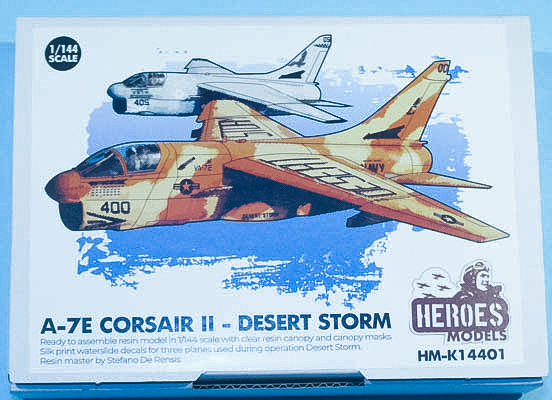
Heroes Models 1/144 A-7E Corsair II - Desert Storm
By Matt Bittner
Introduction
From Wikipedia:
"The Navy was sufficiently impressed with the increased power offered by the A-7D Spey engine used by the Air Force, and decided to use this engine for its own version of the Corsair II. The designation A-7E was assigned, and this version was to succeed the A-7B in production. However, there were delays in the deliveries of the TF41-A-2 engine specified for the A-7E, so the first 67 aircraft of the order were delivered with the TF30-P-8 engine. These aircraft had all of the other improvements planned for the A-7E, including the improved avionics and the M61 rotary cannon, and were re-designated A-7C after delivery.
"The first Spey-powered A-7E flew for the first time on 9 March 1969. The A-7E differed from the USAF A-7D in retaining the probe-and-drogue midair refueling system of the earlier A-7A/B. It entered service in Southeast Asia in May 1970 with VA-146 and VA-147 deployed aboard USS America. The A-7E participated in numerous close-air support missions over both North and South Vietnam, the A-7E's state-of-the-art bombing and navigation system being particularly reliable and accurate. Most air wings operating A-4 Skyhawks and early A-7s were re-equipped with A-7Es. The A-7E participated in the mining of Haiphong harbor in 1972, and played a vital role in Operations Linebacker I and Linebacker II that led up to the formal end of US involvement in the Vietnam War on 24 January 1973.
"On 15 May 1975, A-7E aircraft operating from USS Coral Sea, in conjunction with A-7D aircraft assigned to the 3d TFS at Korat RTAFB, provided air cover in what is considered the last battle of the Vietnam War, the recovery of SS Mayagüez after it was hijacked by Khmer Rouge gunboats. By the time the Mayaguez incident was over, three USAF Sikorsky CH-53 Sea Stallion helicopters had been shot down, two airmen, 11 Marines and two Navy Corpsmen had been killed in action and a further three Marines were missing in action."
The Kit
The Heroes Models 1/144 A-7E Corsair II consists of 41 pieces of gray resin, two pieces of clear resin (separate canopy and windscreen), a set of masks for the canopy, and decals for three A-7Es:
- LTV A-7E 160552, VA-72 Blue Hawks, USS John F. Kennedy, Iraq 1991
- LTV A-7E 160713, VA-46 Clansmen, USS John F. Kennedy, Iraq 1991
- LTV A-7E 160286, VA-72 Blue Hawks, USS John F. Kennedy, Iraq 1991
Decals appear to be in register and are nicely printed. Note that while the kit contains external fuel tanks, it does not come with any other external stores. However, Heroes Models do sell those separately.

|
Construction steps are different than most other instructions. It has the following seven main areas: Fuselage Assembly; Cockpit Assembly; Wings Assembly; Main Landing Gear Assembly; Nose Landing Gear Assembly; Fuel Tanks Assembly; and Final Assembly.
For the Fuselage Assembly you add the horizontal tails, missile rails and - if the type calls for it - the AN/ALQ-126 ECM pod (and all three aircraft catered for in this release did carry the pod).
There isn't much to the Cockpit Assembly, although be sure you notice the very small drawing pointing out how to paint the control column along with how the masks work with the windscreen. There are two ejection seats with this model, an SJU-8 for late USN/Foreign jets and the ESCAPAC IG-2 seat, used on early USN and USAF birds. This section of the instructions have you add the control stick, the ejection seat of choice, the instrument panel and the windscreen.
The Wing Assembly step just has you add the weapon pylons to the underside of the wing, based on measurements provided.
The Main Landing Gear Assembly is as it sounds and shows where all those bits go. This step is probably best left until after painting and decaling, though.

|
Same goes with the Nose Landing Gear Assembly step. Leave those pieces off until as a last stage.
The Fuel Tanks Assembly step just has you glue the rear of the fuel tanks to the front.
For the Final Assembly you glue the fuel tanks to the inner most pylons and the canopy to the fuselage. This step also shows what masks are used on that canopy, best applied before painting.
As I already mentioned, this kit does not come with any type of ordnance, not even Sidewinders. So if you want to add any of those to this kit, then you'll need to source them yourself. As was also already mentioned, Heroes Models has you covered, except for the Sidewinders.

|
Conclusion
This is an excellent kit. Take a look at the detail on the close-up shot of the fuselage and you can see the detail is top notch. There is no better A-7E in 1/144 on the market, so this is definitely the "go to" kit for the Corsair II in 1/144. Remember that Heroes Models also sells all A-7E decals separately. Definitely buy this kit, and know that Heroes Models has recently released the A-7D in 1/144 as well.
